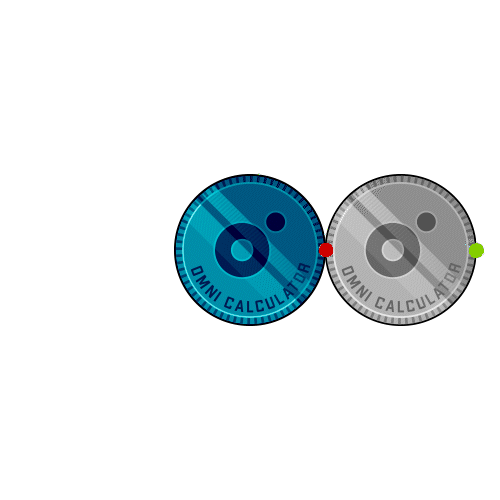1. What is a Coin Rotation Paradox Calculator?
Definition: This calculator computes the number of rotations a smaller coin completes when it rolls around a larger fixed coin without slipping, based on the diameters of both coins.
Purpose: It helps users understand the coin rotation paradox, a counterintuitive phenomenon in geometry, with applications in education, engineering, and design.
2. How Does the Calculator Work?
The calculator uses the following method to compute the number of rotations:
- Convert Diameters to Radii: ,
- Number of Rotations: , where is the radius of the fixed coin and is the radius of the rotating coin.
Unit Conversions:
- Input Dimensions: m, cm (1 m = 100 cm), mm (1 m = 1000 mm), in (1 m = 39.3701 in), ft (1 m = 3.28084 ft), yd (1 m = 1.09361 yd)
Steps:
- Input the diameters of the fixed and rotating coins with their units.
- Convert the diameters to radii in meters for calculation.
- Validate the inputs (diameters must be positive).
- Calculate the number of rotations using the formula.
- Display the result, formatted to 4 decimal places.
3. Importance of Coin Rotation Paradox Calculations
Understanding the coin rotation paradox is crucial for:
- Geometry Education: Illustrating the difference between rotation and revolution in circular motion.
- Engineering Design: Designing gears, wheels, and rotating components where rotational dynamics are key.
- Astronomy: Understanding concepts like sidereal time, where the Earth's rotation and revolution lead to similar paradoxical results.
4. Using the Calculator
Examples:
- Example 1: For a fixed coin diameter of 24 mm and a rotating coin diameter of 24 mm (identical coins):
- Convert: Fixed coin radius , Rotating coin radius
- Number of Rotations:
- Result: The rotating coin completes 2 rotations.
- Example 2: For a fixed coin diameter of 30 mm and a rotating coin diameter of 10 mm:
- Convert: Fixed coin radius , Rotating coin radius
- Number of Rotations:
- Result: The rotating coin completes 4 rotations.
5. Frequently Asked Questions (FAQ)
Q: What is the Coin Rotation Paradox?
A: The coin rotation paradox is a counterintuitive phenomenon where a coin rolling around another coin without slipping completes more rotations than expected. For identical coins, the rotating coin completes 2 rotations instead of the intuitive 1.
Q: Why does the rotating coin make more rotations than expected?
A: The extra rotation comes from the revolution around the fixed coin. The center of the rotating coin travels a path with a radius equal to the sum of the two radii, leading to an additional rotation beyond the rolling motion.
Coin Rotation Paradox Calculator© - All Rights Reserved 2025
 Home
Home
 Back
Back
